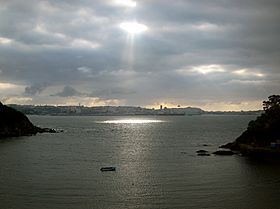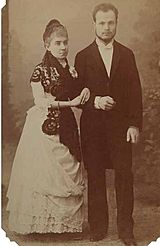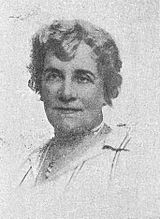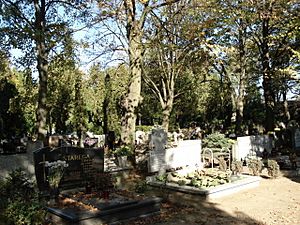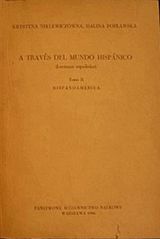Sofía Casanova facts for kids
Quick facts for kids
Sofía Casanova
|
|
|---|---|
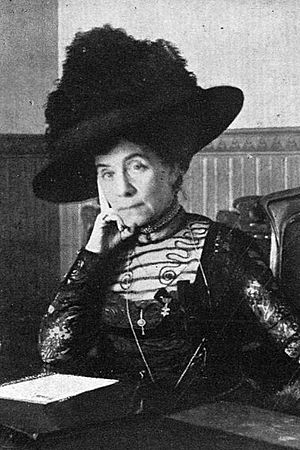
Sofía Casanova, 1910s
|
|
| Born |
Sofía Guadalupe Pérez Casanova
30 September 1861 Almeiras, A Coruña, Kingdom of Spain
|
| Died | 16 January 1958 (aged 96) |
| Occupation | Journalist, writer |
| Organization | Royal Galician Academy |
| Spouse(s) | Wincenty Lutosławski |
| Awards | Grand Cross of the Civil Order of Beneficence |
Sofía Casanova (born September 30, 1861 – died January 16, 1958) was a famous Spanish poet, novelist, and journalist. She was the first Spanish woman to work as a permanent reporter in another country. She was also a war correspondent, meaning she reported from places where wars were happening.
Sofía was known for writing about the human side of conflicts. She reported on the struggles of regular people during wars for the newspaper ABC. She traveled a lot in Europe, seeing big events like World War I, the fall of the Russian Empire (called Czarist Russia then), the start of the Bolshevik government, and World War II. She wrote for many newspapers and magazines, both in Spain and internationally, like New York Times. Sofía Casanova lived a long life and wrote many different kinds of stories and poems.
Contents
- Sofía's Early Life and Family
- Life at the Royal Court
- An Unhappy Marriage and New Experiences
- Becoming a Recognized Writer
- A War Correspondent's Life
- Happy Years in Poland
- Views on the Spanish Republic and Civil War
- World War II and Later Life
- Sofía's Work and Impact
- Sofía Casanova's Legacy
- Works by Sofía Casanova
- See also
Sofía's Early Life and Family
Sofía Casanova came from a family with roots in many countries. Her grandfathers were from Portugal and Spain, and her grandmothers had Dutch and Basque backgrounds. Her father, Vicente Pérez Eguía, worked as a lithographer. Her mother was Rosa Casanova Estomper.
Sofía was born before her parents were married, which was unusual at the time. Her parents married in 1863. A few years later, in 1865, her father left the family and moved to Madrid. He later disappeared and faced legal problems.
Sofía, her mother, and her siblings stayed in A Coruña, supported by her maternal grandfather. She spent her childhood in a place called Pazo del Hombre. In 1873, her family moved to Madrid. Life was hard at first, and Sofía gave lessons to help her family. Things got better when they received some money from her father's family.
Becoming a Poet
In Madrid, Sofía studied poetry and public speaking. Her first poems were printed when she was just fifteen years old in the newspaper Faro de Vigo. It was her mother who sent them in after finding them in Sofía's room.
Sofía's talent for poetry was quickly noticed by important writers in Madrid. She became friends with many literary figures, including Blanca de los Ríos. A powerful person named Marquis of Valmar helped her publish poems in several Madrid newspapers. By the early 1880s, Sofía was known as a promising young poet.
Life at the Royal Court
Sofía started reading her poems at public events in the late 1870s. She also began acting in theaters like Teatro Español. She was first known as "Sofía Pérez Casanova" but later became known simply as "Sofía Casanova."
She became a special student of Ramón de Campoamor, a famous writer. He introduced her to important literary gatherings. There, she met many thinkers and writers of her time, including George Bernard Shaw. She was also invited to the royal court to recite poetry, and King Alfonso XII especially enjoyed her work.
In 1885, Sofía published her first book of poems, called Poesias. The king himself helped pay for the book. This made her even more popular. People described her as a poet with an "inspired spirit and a beautiful face."
Marriage to Wincenty Lutosławski
In 1886, Sofía met Wincenty Lutosławski, a young Polish nobleman who later became a philosopher. He fell in love with her quickly, and they wrote letters for several months. They married on March 19, 1887. They even signed a secret paper saying they could separate if either wanted to.
An Unhappy Marriage and New Experiences
After their wedding, Sofía and Wincenty traveled to Portugal for their honeymoon. Then they moved to Wincenty's family home in Drozdowo, Poland. Sofía first spoke French with her new family, then slowly learned Polish. She quickly won over her husband's family with her kind and cheerful personality.
The couple moved around a lot, living in Switzerland, Russia, and then Krakow in Austro-Hungary. They had four daughters: María, Izabela, Yadwiga, and Halina. Sadly, Yadwiga died in 1895, which made Sofía very sad.
Sofía and her family visited Galicia, Spain, every summer. This helped her stay connected to her home country. During these years, she wrote less. Her only book from this time was El doctor Wolski: páginas de Polonia y Rusia (1894), which was based on her experiences in Poland and Russia.
In the early 1900s, Sofía and Wincenty grew apart. In 1909, Wincenty sold their house in Warsaw without telling her. Sofía decided to return to Spain with her youngest daughter and lived with her brother in Madrid. Wincenty remarried, which upset his own family, who supported Sofía.
Becoming a Recognized Writer
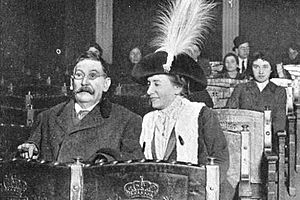
Sofía's many travels and her love for learning helped her become fluent in six languages besides Spanish and Galician: French, English, Italian, Polish, Portuguese, and Russian. These skills were very useful for her future translation work.
Her travels also allowed her to meet famous people like Leo Tolstoy, Marie Curie, and Alfred Morel-Fatio. She wrote about their ideas in her books and talks. Her home in Madrid became a meeting place for many important Spanish writers and thinkers.
When she returned to Spain, Sofía started writing with new energy. In 1909, she published Más que amor, a romance novel that hinted at her own difficult marriage. She wrote other novels and essays about cultural differences. Her name often appeared in Spanish newspapers, and she was seen as one of the "distinguished women" in literature.
Sofía was one of the few women praised by the famous Spanish writer Benito Pérez Galdós. In 1913, he helped stage her first play, La madeja, at the Teatro Español. In 1906, she was chosen as a member of the Royal Galician Academy, and in 1911, she joined the Academy of Spanish Poetry. This showed how much her literary work was respected.
A War Correspondent's Life
Sofía often visited Poland, where some of her daughters lived. In July 1914, while she was there, World War I began. She stayed in Warsaw and worked as a nurse for dying soldiers. This terrible experience deeply affected her and changed her life.
She started sending reports about the war to Spanish newspapers. In December 1914, the owner of ABC newspaper asked her to become their official correspondent in Eastern Europe, and she accepted. This made her a pioneering woman in journalism.
In 1915, as German forces advanced, Sofía and her daughters had to leave Warsaw. They went to Minsk and then Moscow. She continued to send war reports and also helped by distributing food and medicine to troops. Later, she moved to St. Petersburg.
Reporting on the Russian Revolution
In St. Petersburg, Sofía witnessed the fall of the Russian monarchy and reported on it. She faced difficulties, including being censored for her stories. In 1917, she saw the February Revolution, where people rose up against the government. She initially felt sympathy for the soldiers and workers.
During a street protest, Sofía was accidentally hit in the eyes, which badly affected her vision. Despite this, she kept writing. She was an eyewitness to the Bolshevik takeover in October 1917 and even managed to interview Trotsky, a key leader of the revolution. Her views on the revolution changed after two of her husband's half-brothers were killed by the Bolsheviks. In 1918, Sofía and her family managed to leave St. Petersburg and return to Warsaw.
Happy Years in Poland
After returning from Russia in 1918, Sofía settled in Warsaw, which was now the capital of independent Poland. She lived with her oldest daughter's family. This was a very happy time for her. She was surrounded by her loving family and grandchildren. She published many books and was highly respected in both Spain and Poland. She even said she felt "polonized," meaning she felt very Polish.
By the early 1920s, all three of her daughters were married and had successful lives. Her daughters and their families were close friends with Roman Dmowski, a Polish nationalist leader. Sofía herself supported nationalist ideas, believing that strong leadership was better than democracy in some cases.
Sofía often visited Spain. In 1919, she was welcomed as a hero. In 1925, King Alfonso XIII gave her a special award, the Grand Cross of the Civil Order of Beneficence, for her work with the Red Cross during World War I. In 1926, she was even nominated for the Nobel Prize in literature.
She continued to write many articles for Spanish newspapers, especially ABC, reporting from Poland. By the early 1930s, she had published 17 books in Spain. She was seen as an important literary figure in both Spain and Poland.
Views on the Spanish Republic and Civil War
In 1931, Sofía saw the start of the Second Spanish Republic in Spain. She worried that Spain would experience the same kind of chaos she had seen in Russia in 1917. When the newspaper ABC was temporarily closed, she lost her job for a few months. This made her dislike the Republicans.
When the Spanish Civil War began in 1936, Sofía was in Warsaw. She quickly supported the Nationalists, led by Francisco Franco. She and her family took part in events to support the Nationalist cause in Poland. She wrote articles for the Nationalist-controlled ABC newspaper, strongly supporting their side.
Sofía visited Spain in late 1938 and met Francisco Franco twice. He even gave her a signed family photograph. She believed that the military uprising would bring good things to Spain. This was the last time she visited her home region of La Coruña.
Some historians say that Sofía's support for the Nationalists was influenced by her difficult experiences during the Russian Revolution. She saw the Nationalists as bringing order and peace.
World War II and Later Life
When World War II started, Sofía was still in Warsaw with her oldest daughter. To help her stay safe during the German occupation, the Spanish ambassador gave her a Spanish passport. She continued to write for ABC, strongly criticizing Germany's actions in Poland. However, her editor at ABC told her to stop writing about this, which deeply disappointed her.
Sofía had chances to return to Spain, but she chose to stay in Poland with her family. She remained strong and went to church every morning. She was a devout Catholic and struggled with her strong feelings against those who harmed Poland.
In 1944, her Warsaw house was destroyed during the Warsaw Uprising. She then moved to Poznań to live with her daughter Halina's family. Most of her writings were lost in the fighting. Even though she was almost blind, she kept writing by dictating her stories to her grandchildren.
Sofía Casanova died in Poznań on January 16, 1958. Her death was noted in some Spanish newspapers. She is buried in the Jan Vianney cemetery in Poznań.
Sofía's Work and Impact
Sofía Casanova was recognized for her work worldwide. In 1906, she became a member of the Royal Galician Academy, and in 1952, she was given the special title of academic of honor.
She wrote many novels, short stories, a play, and over 1,200 articles for newspapers and magazines. Her works included poetry, plays, and books about social and political issues. She gave many talks about women's roles and international relations. She also translated famous Polish and Russian books into Spanish.
As a journalist, she wrote nearly 1,000 articles. Her reports for ABC from 1915 to 1936 are especially notable. She also wrote books like De la Revolución rusa (1917) and La revolución bolchevista, Diario de un testigo (1920), which shared her experiences of the Russian Revolution.
Sofía believed in peace and was against war. She showed this in her writings about conflicts like the Rif War and the Tragic Week in Spain. Her book De la guerra (1916) strongly showed her anti-war views.
Her love for learning led her to master six languages. She translated works by famous Polish writers like Henryk Sienkiewicz into Spanish. Her own books were also translated into French, Polish, Swedish, and Dutch.
Sofía Casanova's Legacy
While Sofía Casanova was very popular in her time, she is not as widely known today among the greatest Spanish writers. However, there has been a renewed interest in her since the 1990s. Several books and over 50 scientific articles have been written about her life and works in recent years.
Most authors today see Sofía not just as a great writer, but as an extraordinary person who lived a fascinating life. She crossed many cultural borders and witnessed major historical events like the Russian Revolution and both World Wars. She is studied for her role in journalism, women's movements, and how she dealt with different cultures.
In 2011, a documentary movie was made about Sofía Casanova. In 2016, a biographical novel about her, Azules son las horas, was published. Today, at least two schools in Galicia are named after Sofía Casanova, and some cities have streets named in her honor.
Notable Family Members
Sofía Casanova had many talented grandchildren and great-grandchildren. Her grandson Karol Meissner became a respected Benedictine priest and academic. Her granddaughter Maria Niklewicz became a nun. Another granddaughter, Krystyna Niklewicz, was a Spanish scholar and translator. Her great-grandson Krzysztof Meissner is a well-known theoretical physicist.
Works by Sofía Casanova
- El doctor Wolski: páginas de Polonia y Rusia, Madrid, 1894
- Princesa del amor hermoso, Madrid, 1909
- La mujer española en el extranjero, Madrid, 1910
- El pecado, Madrid, 1911
- Exóticas, Madrid, 1913
- La madeja, Madrid, 1913 (a play)
- El crimen de Beira-Mar, Madrid, 1914
- De la guerra: crónicas de Polonia y Rusia. Primera serie, Madrid, 1916
- De la Revolución rusa en 1917, Madrid, 1917
- Sobre el Volga helado, Madrid, 1919
- Triunfo de amor, Madrid, 1919
- El doctor Wolski, Madrid, 1920
- Lo eterno, Madrid, 1920
- La revolución bolchevista: (diario de un testigo), Madrid, 1920
- Viajes y aventuras de una muñeca española en Rusia, Burgos, 1920
- Episodio de guerra, Madrid, 1921
- Princesa rusa, Madrid, 1922
- Valor y miedo, Madrid, 1922
- Kola el bandido, Madrid, 1923
- En la corte de los zares, Madrid, 1924
- El dolor de reinar, Madrid, 1925
- Amores y confidencias: de Rusia, Madrid, 1927
- Las catacumbas de Rusia roja, Madrid, 1933
- El martirio de Polonia, 2nd ed. Madrid, 1945
- Como en la vida, Madrid, 1931, 1947
- Idilio epistolar, Madrid, 1931
See also
 In Spanish: Sofía Casanova para niños
In Spanish: Sofía Casanova para niños


